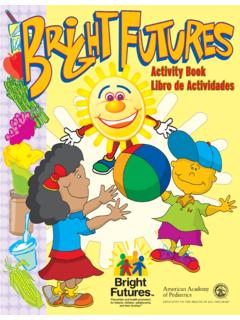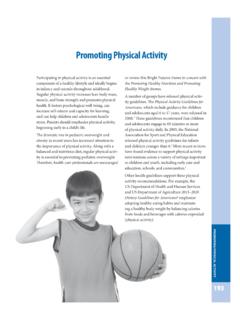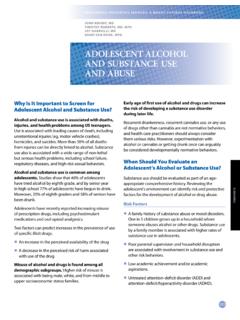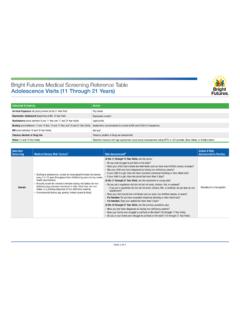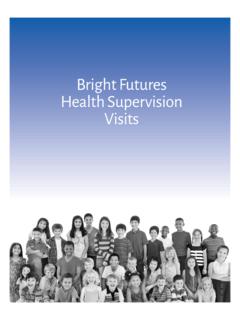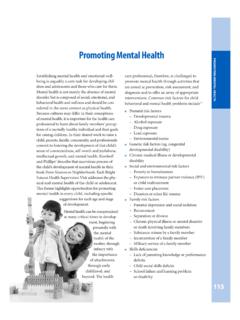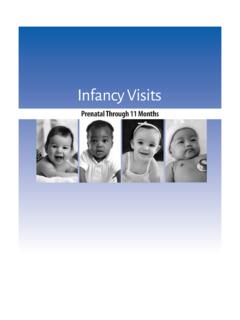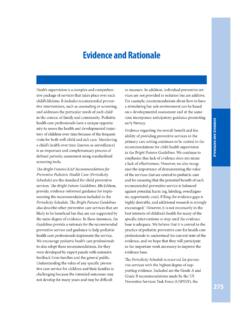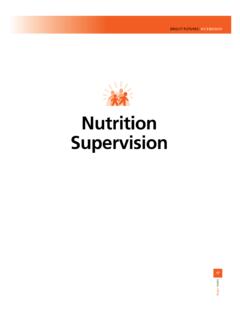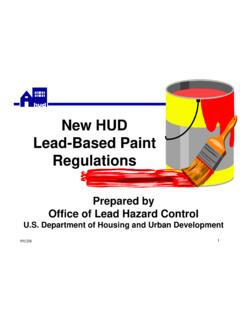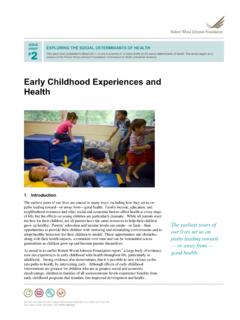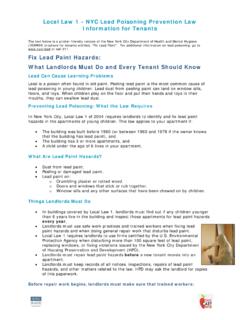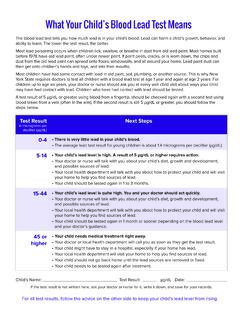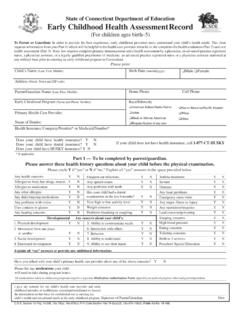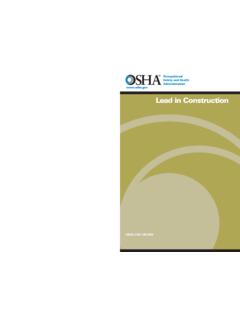Transcription of Early Childhood Visits - American Academy of Pediatrics
1 1 Through 4 YearsEarly Childhood VisitsBFG 4TH 5011/20/17 2:47 PMBFG 4TH 5021/20/17 2:47 PM503 Early CHILDHOOD12 MONTH VISITE arly Childhood12 Month VisitThe 12-month-old stands proudly, somewhat bow-legged, belly protruding. Walking, one of the most exciting developmental milestones, occurs around the toddler s first birthday, bringing with it increas-ing independence. During the first year of life, the infant was rarely in conflict with his environment. He might have been demanding when he cried, he required considerable care, and he changed the balance in the family. However, he spent most of his first year getting to know and trust his parents and his environment. As a toddler, he becomes increasingly competent in acting upon the world around him, all on his own. His world broadens, bringing both excitement and and independent mobility are develop-mental achievements of which the parents and toddler are justifiably proud, but the toddler constantly encounters environmental barriers.
2 He cannot go as fast as he would like without trip-ping, he cannot always reach desired objects, and he can fall and hurt himself. New hazards emerge, such as cups full of hot coffee left on surfaces within reach or stairs without gates. A toddler s parents and other caregivers must watch him constantly to keep him the toddler s autonomy, independence, and cognitive abilities increase, he begins to exert his own will. In response, his parents perceptions of his demands change dramatically, influenced by their own upbringing and Childhood experi-ences. Do the parents understand their toddler s needs and attempt to meet them? The 12-month-old s dramatic struggle for autonomy will test his Context parents ability to let go, permit independence, and enjoy aspects of his behavior that are out of their direct control. The toddler s messy attempts to feed himself can be difficult for his parents as they sort out their own desire for order and neatness with his need for self-care.
3 Fortunately, the toddler is endowed with a social feedback loop to recognize both pleasure and dis-pleasure from significant caregivers. Adults build on this characteristic by providing appropriate responses to a toddler s actions. Adult laughter during a well-played game of peekaboo holds the key to future good times in other interactive games, and turning away, ignoring, or expressing displeasure at a plate of food thrown on the floor, which sends a message that this behavior is not acceptable, helps prevent later disruptive behaviors. Positive activities, such as cuddling, holding, prais-ing, and firmly enforcing rules about not biting, hitting, and kicking, help the toddler develop emotional expression. Consistency is the keystone for dealing with a 12-month-old, and establishing regular routines is all-important. Although the toddler s level of activity increases significantly during this period, his rate of weight gain decreases, and struggles over eating arise for many parents.
4 A toddler frequently eats a large amount at one meal and very little at the next. However, hunger guides him and he eats a suffi-cient amount over time. Not overfeeding is impor-tant to help prevent obesity. The key is to offer nutritious foods consistently and not worry about whether all the food is finished each time. BFG 4TH 5031/20/17 2:47 PMBright Futures Guidelines for Health Supervision of Infants, Children, and Adolescents504 Early CHILDHOOD12 MONTH VISITFood should not be a reward for good behavior, nor should food be withheld as a punishment for bad behavior, as it can lead to obesity and it is an ineffective disciplinary technique. Responding sensitively to the 12-month-old s behavior is a complex task. Some parents who did well with the more dependent, younger infant are less confident of their role now. Toddlers begin-ning their second year of life thrive when parents accommodate their demands yet maintain a strong parenting presence, including a full measure of patience, enough self-confidence to set limits, the judgment to know which needs are most impor-tant, and the ability to realize that their 12-month-old s negative behavior is not directed against them.
5 Physical interaction promotes fun in being active. Reading aloud and singing are positive ways to spend time together and can be worked into the child s daily routines, such as at bedtime or naptime and before mealtime. By letting the child choose the book, the parent can support the child s growing independence and, by reading aloud and naming the pictures, the parent can help the child learn language and satisfy his curiosity about the world. Television (TV) and other digital media should be discouraged at this age. Parents need to be positive role models for their toddler, both physically (eg, by eating nutritiously, being physically active, wearing seat belts in the car, and reading for pleasure) and emotionally (eg, by being calm and consistent in setting limits and handling tantrums). Parents who enjoy their toddler s growing independence can best provide a stable home base as the toddler s curiosity and mobility carry him into an expanding this age may be uncomfortable about being restrained in their activity.
6 The physical examination may be more successfully performed while the child is on a parent s lap or standing on the floor. Speaking directly to the child and taking a playful stance about the examination will make it easier for the child to cooperate. If the child becomes upset, it is a good idea to remind the par-ent that this reaction is expected at this age. As part of the complete physical examination, perform the noninvasive procedures first, with the eyes, ears, nose, mouth, and abdomen examined last. Priorities for the 12 Month VisitThe first priority is to attend to the concerns of the parents. In addition, the Bright Futures Early Childhood Expert Panel has given priority to the following topics for discussion in this visit: XXSocial determinants of healtha (risks [living situation and food security; tobacco, alcohol, and drugs], strengths and protective factors [social connections with family, friends, child care and home visitation program staff, and others])XXEstablishing routines (adjustment to the child s developmental changes and behavior; family time; bedtime, naptime, and teeth brushing.)
7 Media)XXFeeding and appetite changes (self-feeding, continued breastfeeding and transition to family meals, nutritious foods)XXEstablishing a dental home (first dental checkup and dental hygiene)XXSafety (car safety seats, falls, drowning prevention and water safety, sun protection, pets, safe home environment: poisoning)a Social determinants of health is a new priority in the fourth edition of the Bright Futures Guidelines. For more information, see the Promoting Lifelong Health for Families and Communities 4TH 5041/20/17 2:47 PMBright Futures Guidelines for Health Supervision of Infants, Children, and Adolescents505 Early CHILDHOOD12 MONTH VISITThe Bright Futures Tool and Resource Kit contains Previsit Questionnaires to assist the health care profes-sional in taking a history, conducting developmental surveillance, and performing medical screening. HistoryInterval history may be obtained according to the concerns of the family and the health care profes sional s preference or style of practice.
8 The following questions can encourage in depth discussion:General QuestionsX What are you most proud of since our last visit? (If the parent responds, Nothing, the clinician should be prepared with a compliment, such as, You made time for this visit despite your busy schedule. )X Tell me how things are going at home and how your family is adapting to your 12-month-old. X What changes have occurred in your family since your last visit? What is the effect of these changes on your family?X Where are you currently living? Does anyone else care for your child other than you? Do you have any child care needs? Do you feel your child is safe?X What do you like most about your son/ daughter?X What questions or concerns would you like to share with me about your child? X What makes you feel hopeful and optimistic?X What kinds of media does your toddler see (eg, TV, video, cell phone, or other digital media)?
9 Past Medical HistoryX Has your child received any specialty or emergency care since the last visit?Family History X Has your child or anyone in the family (parents, brothers, sisters, grandparents, aunts, uncles, or cous-ins) developed a new health condition or died? If the answer is Yes: Ascertain who in the family has or had the condition, and ask about the age of onset and diagnosis. If the person is no longer living, ask about the age at the time of History X See the Social Determinants of Health priority in Anticipatory Guidance for social history SupervisionBFG 4TH 5051/20/17 2:47 PMBright Futures Guidelines for Health Supervision of Infants, Children, and Adolescents506 Early CHILDHOOD12 MONTH Visits urveillance of DevelopmentDo you or any of your child s caregivers have any specific concerns about your child s development, learning, or behavior? Clinicians using the Bright Futures Tool and Resource Kit Previsit Questionnaires or another tool that includes a developmental milestones checklist, or those who use a structured developmental screening tool, need not ask about these developmental surveillance milestones.
10 (For more information, see the Promoting Healthy Development theme.)Social Language and Self helpDoes your childX Look for hidden objects?X Imitate new gestures?Verbal Language (Expressive and Receptive)Does sheX Use Dada or Mama specifically?X Use 1 word other than Mama, Dada, or personal names?X Follow directions with gestures, such as motioning and saying, Give me (object) ? Gross MotorDoes heX Take first independent steps?X Stand without support?Fine MotorDoes sheX Drop an object in a cup?X Pick up small object with 2-finger pincer grasp?X Pick up food and eat it?BFG 4TH 5061/20/17 2:47 PMBright Futures Guidelines for Health Supervision of Infants, Children, and Adolescents507 Early CHILDHOOD12 MONTH VISITR eview of SystemsThe Bright Futures Early Childhood Expert Panel recommends a complete review of systems as a part of every health supervision visit. This review can be done through questions about the following:Do you have concern about your child sX Head Shape X Eyes Cross-eyed X Ears, nose, and throatX BreathingX Stomach or abdomen Vomiting or spitting Bowel movementsX Genitals or rectumX SkinX Development Muscle strength, movement of arms or legs, any developmental concernsObservation of Parent-Child InteractionDuring the visit, the health care professional acknowledges and reinforces positive parent-child interactions and discusses any concerns.
